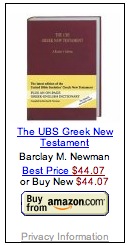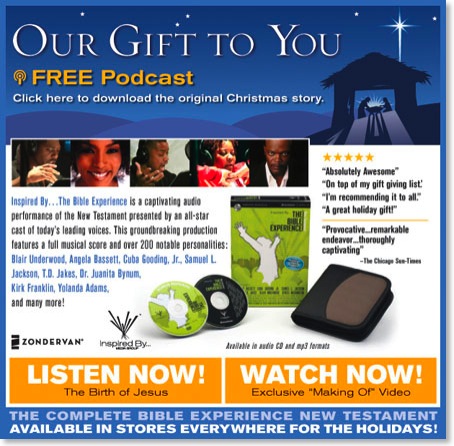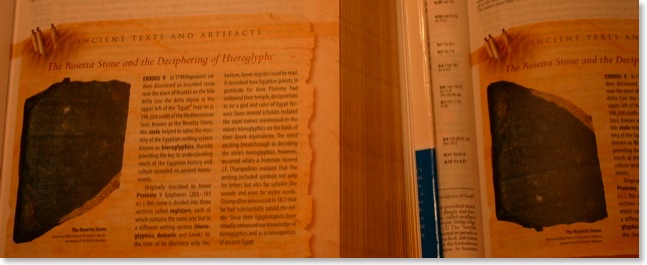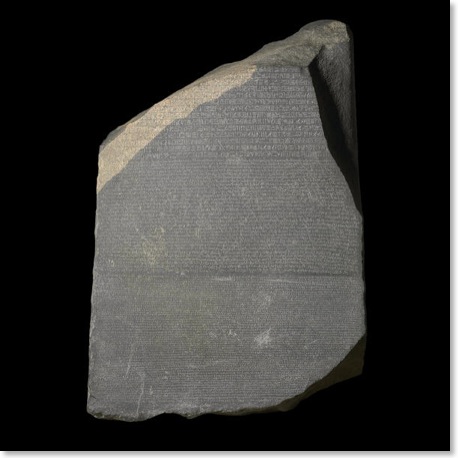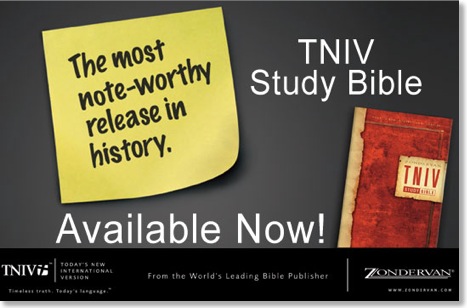TNIV Gate Keeper Profiles, Part 3
Jeremy O'Clair
Church of Christ, College-level Bible Teacher
Tallahassee, Florida
I've been using the TNIV for about three years now. At my (then) seminary, our dean passed out TNIV Bibles to all the seminary students interested in having a copy -- a simple black hardback. Since it was a relatively new release I decided to give it a try and came to like the overall clarity of the translation. I started out reading through the Bible with the TNIV audio online (Genesis, Exodus, etc.), and really liked how clear and understable the translation was for me. Of course, I would check it against the original Hebrew or Greek if there was a passage I wanted to investigate closer through a word study or exegesis.
In summer 2007 I taught a class on Galatians using the TNIV while interning at my parents' church; then after moving to Tallahassee last fall I also taught Galatians, with the TNIV, at the church I attend, teaching the college class. Since then we've worked through 2 Peter and some history of the Bible. I'm now co-teaching through the book of Romans while I use the TNIV and the other teacher uses his NRSV -- so it should be interesting how the class turns out when comparing the two translations!
The gender inclusive language is another reason I use the TNIV. I like the rendering of the generic masculine nouns (such as anthropos, adelphoi, etc.), but how the TNIV, naturally, retains gender specific words such as ἀνήρ/aner and γυνή/gune. I've been trying to enlighten people on this subject, with the TNIV in one hand, and Greek text in the other, looking at this translation preference in many passages (there weren't mere brothers in the congregations but there were brothers AND sisters!).
Basically, the readability of the TNIV really works for me. For the most part the readings have been quite smooth. But if there is a reading that might seem too glossed over, I'll check the original languages and inform my audience of the translator's task when it comes to translating Scripture.
Debbie Fulthorp
Pastor, Grand Canyon Assembly of God
Grand Canyon, Arizona
My husband and I co-pastor the Assembly of God church inside the Grand Canyon National Park (South Rim). We believe that our church is in a strategic location to reach nations for Christ. We feel that we are not only pastoring a church, but the community God called us to. Because of that reason, we prefer to use the TNIV Bible. We minister on a regular basis to people who are unchurched, and may have never heard the story of Jesus, let alone read the Bible. We have found that using the TNIV circumvents questions about various passages and also uses language non-English speakers can understand. For example, through divinely appointed relationships we were able to give one of the Royalty in Thailand a Bible. Another girl who was Muslim, recently dedicated her life to Jesus. The TNIV is perfect for those who have not been in the church because they can understand that ALL PEOPLE can come the the cross regardless of gender, nationality, age, or economic status.
On a more personal note, I love the TNIV because I am a pastor. I experienced the TNIV my first year in seminary, before I fully understood that God could call a woman to be a pastor. Studying the Greek texts and comparing the TNIV side by side at various texts, brought me one step closer in my journey towards following the will of God for my life. I had no idea God could use me as a pastor, but through studying the TNIV and comparing Greek texts (at the time only New Testament was available) gave me the theological underpinnings for the ministry God placed my husband and I in today.
I love the TNIV because it has given us so many doors for ministry, sharing the gospel to men and women unbiasedly where they can understand it.
My husband and I as well as our church are gatekeepers as we minister together in one of the most transitional places of ministry. We might be a small missions church, but we see the Gates of the Grand Canyon National Park as our place of ministry where every nation, tribe and tongue should have a chance to know God through hearing His Word and experiencing Him through personal relationship!
Feel free to interact with Jeremy & Debbie in the comments.
Other posts:
Part 1
Part 2
Rise of the New Living Translation
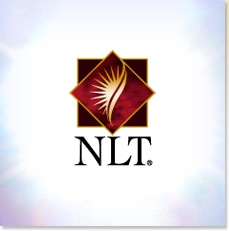
Originally, this week, I was planning to post a preview of the upcoming NLT Study Bible based upon the Genesis sampler I received in the mail over a month ago. I was informed yesterday however, that I would be receiving an advance copy of the entire Bible sometime within the next few days, so that review can wait and I will expand it to cover the entire Bible. Nevertheless, there have been a number of NLT-related issues and trends I’ve been noticing and a number of thoughts have been going through my mind lately. I wondered initially whether I should include them in the review of the NLT Study Bible or treat them separately. I’m going to use this post to do the latter.
THE ELUSIVE COMMON BIBLE. I’ve been collecting and comparing translations of the Bible since my early teenage years. Even after studying biblical languages, I still have a love for English translations, carrying both an English Bible and a Greek New Testament to church on Sundays. Related to that, I’ve watched the trends of what Bibles people carry and read, and I’ve studied the history of English translation development. We live in an age in which we are spoiled by so many translations of the Bible--from every translation methodology and for every niche market. The offset of this fact is that it is now nearly impossible for the church as a whole to embrace ONE Bible as a “common” Bible in the way that the venerable King James Version reigned supreme for nearly three centuries.
And yet even without a common Bible, there is always a preferred Bible, a most often selected, best-selling Bible version. The first Bible version to dethrone King James was the Living Bible in the 1970’s. But this coup was short-lived and the KJV soon regained its kingdom. Nevertheless, it’s interesting to note that the first contender to the KJV for best-selling translation was a Bible that was its complete opposite. The Living Bible wasn’t actually a translation at all, but a paraphrase produced by one man (and later checked by a committee) who had no direct knowledge of the biblical languages. But by the 1970’s the King’s English was quite foreign to the average Christian. Although the Living Bible had many critics at the time, no one argued the fact that it was much easier to understand. And at the time, most Christian homes contained one of those green hardback paraphrases whether it was carried to church or not (and many of them were carried to church).
The Living Bible was certainly not the first Bible to come along with more readable English. Many Bible versions were produced throughout the centuries claiming to the successor to the 1611 “Authorized Version.” Noah Webster and J. N. Darby both attempted to improve upon the KJV in the 19th century. Both of their Bibles were improvements, in the opinions of most, but they never saw widespread acceptance. The 1881 Revised Version and 1901 American Standard Version both sought to replace the KJV as the standard translations for English-speaking Protestants, but while technically translated with more accuracy than the KJV, they did not reflect the beauty of the KJV’s style and never gained wide reading outside primarily academic circles.
In the mid-twentieth century, the Revised Standard Version replaced the KJV for many mainline Protestants, but most Evangelicals looked upon certain renderings in the RSV with suspicion. Thus, the KJV was still able to retain its dominion for a couple of decades more, but its reign as best-selling and most read translation was drawing to a close.
ROYAL DETHRONEMENT. Ultimately, it was the 1978 NIV that would finally and permanently unseat the KJV from the #1 spot. The NIV had a number of things going for it that made it successful where other contender translations had failed. Unlike the Living Bible, the NIV was an actual translation from the Greek and Hebrew texts and was produced by a committee of translators. Reading level was seriously taken into consideration in developing the NIV. The average American reads at a 7th grade reading level and newspapers generally read at that level, too. Considering the fact that the New Testament was written in Koine (common) Greek, why should a Bible be difficult to read? Why should it sound like it was written in a bygone era? Further, unlike the Modern Language Bible, the NIV committee employed stylists that helped keep its translation consistent. While not trying to achieve the majesty of the KJV necessarily, the NIV committee did achieve something that other contenders had not: an accurate, consistent, and readable translation of the Bible. I don’t remember now exactly when it occurred--either in the late eighties or sometime in the nineties--but the NIV became the best-selling, most-used, and most read translation. For millions of people, it opened up the Scriptures and made them readable for the first time.
But let’s be realistic. The NIV is not going to be the Bible of choice for the next three centuries like the KJV was. No translation will ever last that long again because the English language changes too quickly in the modern age. Sadly, the 1978 NIV already sounds a bit dated. And although it is still the best-selling English translation of the Bible, I would suggest that over the next decade another translation is going to replace it in the top spot. I don’t have access to NIV sales figures, but I would guess that its sales are already on the decline. If they aren’t, they will be soon.
WHAT’S NEXT? So what are the contenders? The English Standard Version, Holman Christian Standard Bible, Todays New International Version, the New Living Translation (second edition)--these are all major 21st century translations. If I had been propheticlly looking at this list twenty years ago, it would have been easy to suggest that the TNIV, as an update to the NIV, would be the inheritor of the NIV’s mantle. Even up until recently, I thought it still could be. But I’m less and less certain of that fact.
The TNIV suffers on two fronts: (1) It was the target of a major disinformation campaign that has led to its rejection by many of those who should have been in its target audience; and (2) neither the TNIV’s copyright owner, the International Bible Society, or its major United States distributor, Zondervan, have ever given it precedence over the original NIV in terms of promotion and emphasis.
In regard to the first issue, 50% of stores that belong to the Christian Booksellers Association, including major chains such as Lifeway, refuse to carry the TNIV. Supposedly the TNIV’s primary offense is inclusive language; however, these same stores that won’t carry the TNIV will carry the NLT, the Message, the NCV, the NRSV and others that do contain inclusive language. Further, translation such as the ESV, NASB95, and the HCSB all contain more inclusive language than even the original NIV. This is a heinous double standard. Changing these misconceptions will also require a major re-education campaign on the part of Zondervan and the IBS.
As for concerns with the International Bible Society’s and Zondervan promotion of the TNIV, in March of 2007, I wrote an open letter to both organizations here on This Lamp expressing my concerns. IBS never responded, but Zondervan flew me up to its headquarters in Grand Rapids, Michigan, where I met with editors and marketers--all warm, friendly, and welcoming. I didn’t meet anyone who wasn’t absolutely adamant that the TNIV was the future. I also came to understand better why the company was not in a position to completely remove the NIV from the market. Fine. But there’s evidently a breakdown somewhere.
Run this little experiment. Go to Amazon.com and search for “New International Version.” Then to narrow your results, click on “Books” under “Any category” on the left. Now, change the drop down on the top right to “Publication date.” I count 29 new NIV Bibles already projected for 2009. Run the same search for “Today’s New International Version.” The result? Nothing. You will find results counting new editions for 2008, but in comparison to the new NIV editions for this year, you’ll definitely see where Zondervan’s emphasis is. You ask anyone at Zondervan and they will tell you that the TNIV is the future. But the company simply doesn’t seem to be willing to put that into practice. I’m certain that they fully intend to eventually switch emphasis to the TNIV, but my fear is that by the time they do this, it may be too late for it to matter.
INTERESTING RECENT DEVELOPMENTS. Now, let me show you another interesting indicator of what may be the shape of things to come. Below is the August 2008 translation bestseller list from Christian Booksellers Association. These figures reflect sales from the month of June, 2008.
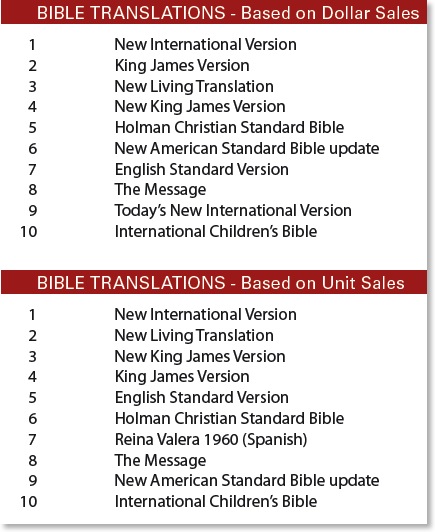
Now, anytime I show CBA translation charts, I always feel obligated to offer a disclaimer. These charts do not reflect the huge number of Bibles sold in non-member stores and bookstore chains including Barnes and Noble and Borders and such. They do not include the sales of retail outlets like Wal-Mart and online retailers like Amazon.com--all of which sell large numbers of Bibles, also. Although some Catholic stores are CBA members, the majority are not; so Catholic translations are never well-represented here. Also, keep in mind that as I have already pointed out, roughly 50% of CBA stores refuse to carry the TNIV, so although it does not show well here, that doesn’t mean that it’s not selling elsewhere. Translations such as the NRSV may also have higher sales that are simply not reflected here. The JPS is a fine translation, but it’s never going to make this list. Okay...
Nevertheless, the above figures do represent an extremely large number of Bibles sold in stores, especially Bibles that Evangelicals are buying. Since we don’t have any actual numbers, obviously the charts are open to a good bit of interpretation. Years ago, while working in a bookstore, I saw a document with some actual numbers. The first three entries counted for the vast majority of all sales. And by the time a translation ranks in the bottom half, we’re usually talking about sales in the single digit percentages.
First let’s look at the charts in regard to the TNIV. The fact that it ranks on dollar sales, but not on unit sales probably means that there aren’t that many inexpensive TNIVs in bookstores. So there aren’t many people buying low cost editions in CBA stores for evangelistic purposes. But what’s surprising is that the TNIV has completely dropped off the units sold chart. So, while it is not carried in every one of these stores, it at least used to still show in the units sold list. The August chart doesn’t mean that the TNIV is not selling in the stores that are carrying it, but it does mean that it has recently been selling less. And I’m sorry, but it boggles my mind that the International Children’s Bible would outsell the TNIV!
But now, let’s look at the chart in regard to the New Living Translation. For the last few years, the NIV, KJV, NKJV and NLT have remained in the top four positions (the HCSB was in the 4th spot after its release for a little over a year). The KJV and NKJV often go back and forth between second and third place, but the NLT is usually ranked fourth.
The unit sales chart has the most significant change. For the first time to my knowledge, the NLT has topped both the KJV and NKJV in unit sells, setting it second only to the NIV. And in dollar sales, it is ranked third and above the NKJV. To my knowledge, the NLT--which has always done fairly well on these charts anyway--has never done this well.
This week, I noticed another interesting development. Over at the NLT Blog, in what was almost an aside comment, it was noted that “Christianity Today, International will be making the NLT the default translation on their websites.” I assume that the NLT is replacing the NIV as the default translation. In my mind, this is an incredibly significant development as Christianity Today, in many ways, represents mainstream Evangelical thought. So it speaks volumes not only to the fact that the NLT was chosen as default translation, but also in regard to the versions that were passed over.
NLT UNDER THE RADAR. Suddenly and seemingly unexpectedly, signs are starting to point to the New Living Translation as a major contender for the spot of top English translation that the NIV has held onto for the last two decades. How did this come about?
Perhaps the success of the NLT can be chalked up to the patient persistence on the part of Tyndale House Publishers as well as near nonstop fine tuning of the translation itself. When the New Living Translation was initially released in 1996, it was far more to the right on the dynamic equivalence scale than it is now. The first edition had many phrasings that still echoed Ken Taylor’s original Living Bible. But with the release of the second edition of the NLT in 2004, a lot of the more dynamic readings were tightened up, active voice replaced passive voice in many passages, and the more questionable renderings were mostly removed. Echoes of the original Living Bible are now all but gone from recent editions of the NLT. I still consider the NLT a dynamic translation, and the best of its breed, but it has now moved much closer to the middle, much closer to the kind of translations I would normally categorize as median translations, containing elements of both formal and dynamic methods, based upon the communicative issues of a particular passage.
In 2007, the NLT was revised yet a third time. But the changes are not as startling as the shift between the first and second edition (see my review of the NLT for discussion of the changes in the second edition). In fact, Tyndale is still referring to the 2007 edition as a second edition, but adding 2007 to the 1996 and 2004 dates. With each revision, the NLT has become...well, I don’t want to say “more literal,” because it’s certainly not a literal translation in the traditional sense of meaning. But it has certainly become less dynamic.
I do not yet have a full 2007 text of the NLT, but when I received the Genesis sampler of the NLT Study Bible, one of the first things I did was to compare the changes in the text from the 2004 edition. As already mentioned, the changes are not on the same level of the change between the 1996 and 2004 editions, in which the NLTse was almost an entirely new translation in my opinion. But the changes reflect a honing of the translation, a fine-tuning of the details if you will. Consider that in Genesis 1-12, there are only 7 verses out of 287 that have been changed from the 2004 edition. That results in a 2.4% change from the 2004 NLTse.
1996 |
2004 |
2007 |
|
1:14 |
And God said, "Let bright lights appear in the sky to separate the day from the night. They will be signs to mark off the seasons, the days, and the years. | Then God said, "Let great lights appear in the sky to separate the day from the night. Let them mark off the seasons, days, and years. | Then God said, "Let lights appear in the sky to separate the day from the night. Let them be signs to mark the seasons, days and years. |
1:16 |
For God made two great lights, the sun and the moon, to shine down upon the earth. The greater one, the sun, presides during the day; the lesser one, the moon, presides through the night. He also made the stars. | God made two great lights, the sun and the moon--the larger one to govern the day, and the smaller one to govern the night. He also made the stars. | God made two great lights--the larger one to govern the day, and the smaller one to govern the night. He also made the stars. |
1:26 |
Then God said, "Let us make people in our image, to be like ourselves. They will be masters over all life--the fish in the sea, the birds in the sky, and all the livestock, wild animals, and small animals." | Then God said, "Let us make human beings in our image, to be like ourselves. They will reign over the fish in the sea, the birds in the sky, the livestock, all the wild animals on the earth, and the small animals that scurry along the ground." | Then God said, "Let us make human beings in our image, to be like us. They will reign over the fish in the sea, the birds in the sky, the livestock, all the wild animals on the earth, and the small animals that scurry along the ground. |
2:5 |
there were no plants or grain growing on the earth, for the LORD God had not sent any rain. And no one was there to cultivate the soil. | neither wild plants nor grains were growing on the earth. The LORD God had not yet sent rain to water the earth, and there were no people to cultivate the soil. | neither wild plants nor grains were growing on the earth. For the LORD God had not yet sent rain to water the earth, and there were no people to cultivate the soil. |
2:10 |
A river flowed from the land of Eden, watering the garden and then dividing into four branches. | A river watered the garden and then flowed out of Eden and divided into four branches. | A river flowed from the land of Eden, watering the garden and then dividing into four branches. |
11:26 |
When Terah was 70 years old, he became the father of Abram, Nahor, and Haran. | When Terah was 70 years old, he had become the father of Abram, Nahor, and Haran. | After Terah was 70 years old, he became the father of Abrah, Nahor, and Haran. |
12:14 |
And sure enough, when they arrived in Egypt, everyone spoke of her beauty. | And sure enough, when Abram arrived in Egypt, everyone spoke of Sarai’s beauty. | And sure enough, when Abram arrived in Egypt, everyone noticed Sarai's beauty. |
Interestingly note that in Gen 2:10, the NLT reverts back to the original 1996 reading. Since writing my initial review of the NLT, I’ve been contacted by a number of NLT1 holdouts. Some people simply prefer the 1996 edition, and my own wife is one of them. Overall, it is more dynamic (though not in Gen 2:10) and that speaks to some people in a greater way. Personally, I have no problem with that, although I believe the changes made in the 2004 edition and now the 2007 revision as demonstrated above are changes for the better.
Over the last few years, I’ve found it quite interesting to watch the TNIV receive criticism in regard to inclusive language when the NLT had used much of the same kind of language almost a decade earlier. I even asked one of the NLT translators about this--why the NLT had remained virtually unscathed while the TNIV took a beating from its detractors. He felt that the TNIV had been a lightning rod for controversy and this allowed the NLT to scoot by a bit under the radar.
And under the radar it is. The NLT has continued to gain readers while improving the translation itself while many have really not realized such changes were going on. Consider that the 2004 update, as radical as it was, barely received mention by Tyndale itself. In fact, when I began planning my review of the NLT in 2006, I was totally unaware the extent of the changes. And I would not have even known about the 2007 revision had a reader of This Lamp not informed me by email.
But if I’m a proponent of the NLT and have been slow to find out about changes to the text, evidently it’s even harder for the detractors. Tim Challies sought to further propagandize the ESV earlier this month by knocking down a few translations he doesn’t like. Evidently, though, he had no idea that the copy of the NLT he was quoting was two editions out of date.
Want further evidence of the NLT’s under-the-radar status? Check out the Wikipedia entries for the ESV, TNIV, and the NLT. The NLT is older than the ESV by five years and the TNIV by nine. The articles for the ESV and TNIV are substantive because they have both been magnets of controversy and have each had their share of supporters and critics. The NLT, on the other hand, doesn’t even have a full article. It’s a stub, and an out of date one at that. Some of the links don’t even work.
Want more? Consider the interview with J. I. Packer from 2006 in which he heartily endorsed the NLT. He even described the NLT as “brilliantly done.” This should be ironic considering Packer was the general editor of the ESV, a translation which in many ways was created to be everything the NLT is not. But it’s not ironic because Packer is not really recommending the NLT as a primary translation. Rather, he thinks of it as a secondary translation, something perhaps to be read beside a more traditional translation like the ESV. He may even think of it in the same vein as the original Living Bible which many used as a simple commentary to the KJV. But the people I see using the NLT are not reading it as a secondary translation. And I can guarantee you that Tyndale is not promoting it to be anything but a primary Bible.
What made the NIV king of the hill beyond its merits as a translation? Well, there were a number of significant editions of the text that were released in the eighties including the NIV Study Bible, the NIV Student Bible and an NIV version of the Thompson Chain Reference Bible. The Expositor’s Bible Commentary, written by top Evangelical scholars demonstrated that the NIV was worthy as a commentary base. The Goodrick-Kohlenberger numbering system tied the NIV’s text to its Greek and Hebrew roots and paved the way for resources like the New International Dictionary of New Testament Theology. Today, there are more modern commentaries based upon the NIV than any other translation.
But now, Tyndale is setting the NLT up for the same kind of reference integration that the NIV has enjoyed. A system known as the “Tyndale-Strong’s numbering system” has been developed to connect the text of the NLT to the original Greek and Hebrew text. In the forthcoming NLT Study Bible, these Tyndale-Strong’s numbers are included right along in the cross reference column next to the text. The Cornerstone Biblical Commentary series and the expanding Tyndale Reference Library relies on the NLT text as well.
Another healthy sign for the NLT can be found in the two NLT-related blogs that have appeared recently. One blog is related to the NLT in general and the other specifically for the forthcoming NLT Study Bible. This is an excellent idea and a wonderful way for Tyndale editors to interact with NLT readers. I made similar recommendations to Zondervan regarding the TNIV as early as two years ago, but an ongoing publisher-based TNIV blog has never become a reality.
Personally, I’ve stated for some time that the NLT is fully capable of being used as a primary English translation for serious study and teaching. Steps are now in place with the growing number of NLT-related resources to make this a reality. And as has been pointed out recently, the NLT translators are no slouches themselves, but rather the cream of Evangelical academia.
LOOKING TO THE FUTURE. In discussing some of these observations with Wayne Leman via email yesterday, he stated “A major translation comes along every few generations and it can become a default translation. The KJV was one of these. The RSV was one, at least for NCC churches. The NIV was one. Now, [in my opinion], the NLT is one. I know that many will disagree with me, but that's okay.” Wayne, who gave me permission to quote him, knows what he is talking about as he is a Bible translation consultant himself and a founder of the Better Bibles Blog.
In my experience, the average Christian really doesn’t pay that much attention to translation issues. I’ve discovered that many people carrying a Bible often can’t tell me what translation they are using without looking at the spine. So, what makes a translation like the NLT rise in popularity, especially among a dozen or so other Bible versions vying for acceptance? I have a hunch that when a person walks into a store looking for a new Bible, he or she opens them up and simply reads various passages. This is where the NLT has the advantage. Without a doubt, of all the major contemporary translations, the NLT’s English sounds the closest to contemporary speech. While some would criticize the NLT for this, we must again remember that the New Testament was originally written in the common speech of the day, not the more formal styles that were used for other, more “official” purposes.
Wayne also wrote yesterday that, “Christian readers today appreciate a Bible version that actually reads as they write and close to how they speak. There have been enough idiomatic English versions around for several decades, so that Christian readers know what good English sounds like in a Bible. If Christian readers have a true choice to purchase a Bible--and don't have to follow the dictates of some ideology--they will often purchase a Bible with good English, at least as a supplement to one that has worse English and is used as their church's pew Bible.”
Readers of This Lamp know that over the past few years when asked for a recommendation for a primary English Bible, I’ve suggested the HCSB, TNIV or NLT. In my own use, the TNIV has been my primary Bible over the last two years, although when I give a Bible to someone who tells me the Bible is difficult to understand, I find that most often I give the NLT. And I’ve done this for well over a decade. In fact, now that I think about it, I’ve given away more NLTs than any other translation in the last ten years, and I have done so because of its superior readability.
I have been teaching from the TNIV the last two years because 70% of those whom I instruct are carrying NIV Bibles. That’s in addition to the fact that I find the TNIV to be an excellent translation. Further, I’ve found that usually a median Bible is best for teaching; although I’ve said that I could use the NLT if enough people in a Bible study or classroom also had the NLT. I’ve often used the NLT in formats that were less interactive such as sermons and devotionals. But the day may be coming in which a majority carries the NLT. If that happens, it would only make sense that I would teach from the NLT. Of course, Tyndale currently lacks a decent NLT reference Bible for teaching or preaching akin to something like the TNIV Reference Bible.
This coming Sunday, I still plan on teaching from the TNIV. But I really wonder what I’ll be teaching from in five years. Could it be that the majority of us will study with the NLT in hand?
I’d really like to have a discussion about this. Let’s avoid the “my translation is better than your translation” kind of nonsense. I don’t believe that for one Bible version to succeed another one must fail. I still recommend reading translations in parallel. Regardless, I believe current trends point to the NLT continuing to gain momentum which may eventually lead to its place as the most used Evangelical translation in a number of years. And it may even be able to reach beyond the walls of Evangelicalism. What do you think? Let me know in the comments.
Zondervan & This Lamp to Give Away TEN Renaissance Fine Leather TNIV Reference Bibles
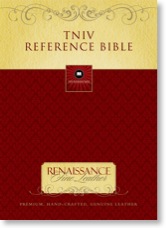
That’s right--Zondervan has offered to give away ten copies of the Renaissance Fine Leather TNIV Reference Bible (a combined retail value of nearly $1,000) to ten qualifying individuals. What must you do to qualify?
- You must be a “Gatekeeper.” What’s a gatekeeper? A gatekeeper in this context is someone who regularly preaches or teaches the Bible in a church or educational setting. For the purposes of this giveaway, if you are a pastor, other minister or teacher of adults and you instruct from the Bible on at least a weekly basis, you are considered a gatekeeper. You should also have been in this position for at least three months.
- You must already use the TNIV as your primary Bible. This is a really nice edition of the TNIV Reference Bible, and Zondervan is being very generous to give these away through This Lamp. So, this is a Bible that’s meant to be used, not one that becomes an addition to your collection of translations.
- In the comments of this post, tell us why you are using the TNIV translation as your primary teaching and/or preaching translation. We’re looking for at least a couple of paragraphs here, not “Because I think it’s really cool.”
- Qualifying winners agree to a follow-up email interview regarding the use of the TNIV in your ministry. Between now and November, I’ll contact you with a few questions based on your post here in the comments. That interview will become the basis of an actual main post here on This Lamp.
- You cannot qualify if you’ve already been deemed a recipient of the similar giveaway on TC Robinson’s website. No double-dipping! And TC emailed me his list of winners!
- Sadly, United States residents only.
If you have any questions, let me know. I’ll post a list of the ten winners once it is finalized.
PLEASE NOTE THAT THIS OFFER HAS NOW ENDED. TEN WINNERS HAVE QUALIFIED.
Preview: TNIV Reference Bible, Renaissance Leather Edition (with photos) [UPDATED]
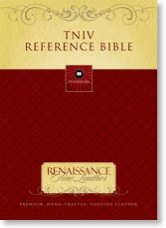
Later this year, Zondervan will release another edition of the TNIVRB, this time with a much nicer cover, described as “Renaissance Fine Leather.” There’s a movement in publishing circles away from naming the animals from which the leather is obtained [I’m still waiting for “genuine dairy cow”], but the new “Renaissance Fine Leather” is
[Update: Okay, here’s the scoop. The Renaissance Fine Leather is cowhide. It is not calf, goat, or pig. I’ve been told that what makes it special is its “Soft supple feel, complemented with stitching accents, & sewn binding.” Further, “the soft supple feel is achieved by the case construction, which has flexible endsheets without a stiff cover board. Some [Renaissance Leather] Bibles also have foam to give it more structure, but maintain the flexibility. So instead of using a thin bookbinding leather and then attaching it to a stiff board (like 99% of Bibles), we use a thicker leather and let the material itself become the cover.”]
The new edition of the TNIVRB has these features:
- November release*
- Over 10,000 references
- Bound in our new premium hand-crafted Renaissance Leather*
- Single Column
- Black letter
- Topical ties at bottom of page
- TWO ribbon markers*
- MSRP: $99.00*
*indicates features pertaining only to the new edition.
I was sent some photos of the new Bible from Zondervan today, which I am reproducing here. Be sure to click on an image to see it in its original size.
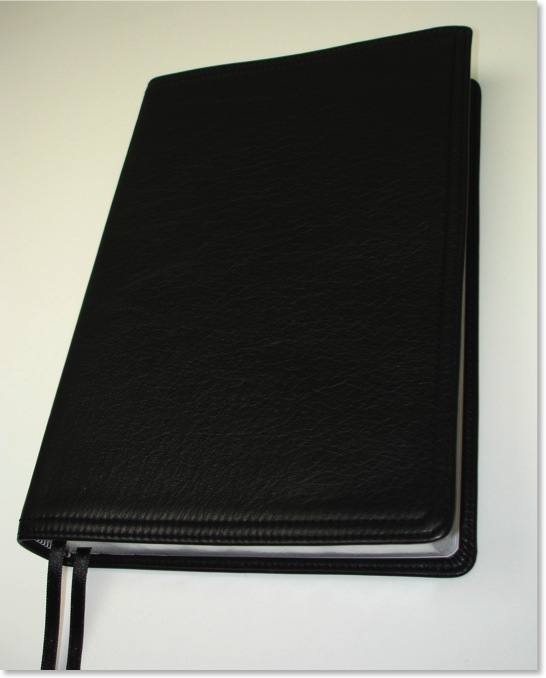
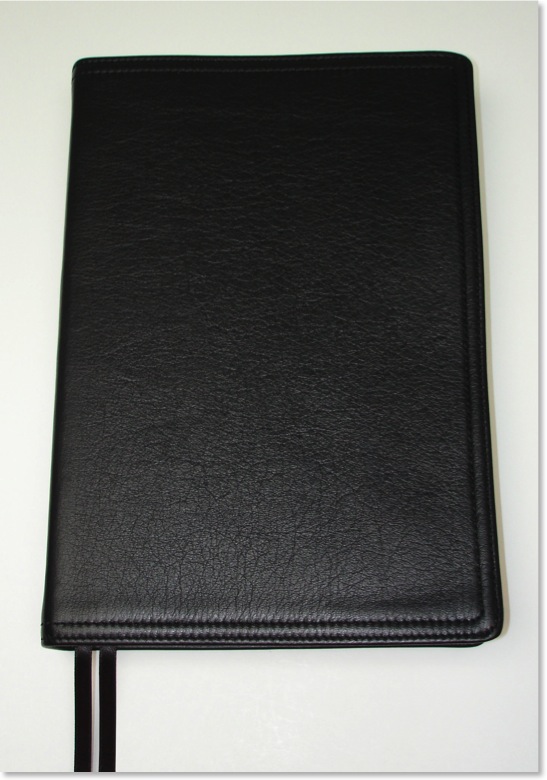
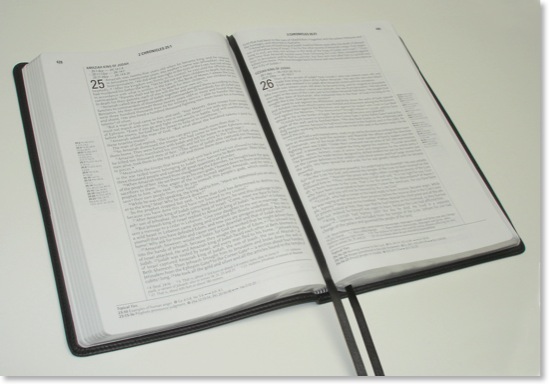
This does, indeed, look to be a very fine Bible. It was described to me in correspondence with these words “I wish you could touch this leather. Smooth as butter. Supple. Exquisite.”
Now, I know that Zondervan has promised to give away some of these Bibles through TC Robinson’s New Leaven website. But today they also contacted me and have generously offered to do something similar through This Lamp.
I’ll spell out the particulars in a day or two, so be sure to stay tuned for more...
TNIV Reference Bible: Hands On Review
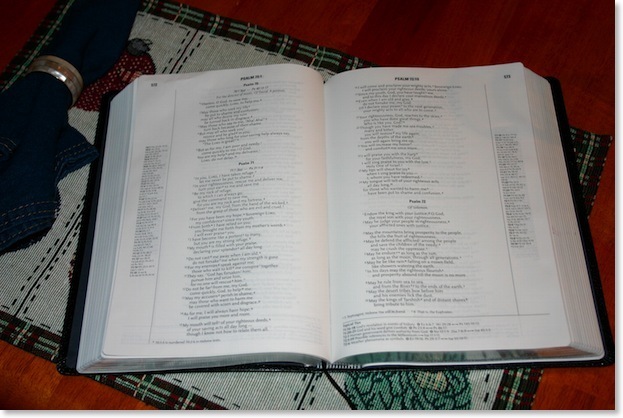
The official word from Zondervan states that the TNIV Reference Bible's official release date is January 2008. However, Christian Book Distributors is showing availability "on or about" December 10 (as of this writing, CBD did not have any copies yet). The TNIVRB has been a highly anticipated Bible for a number of reasons. The complete TNIV translation has only been in circulation for about two and a half years, andI started teaching primarily from it in the latter half of 2006. However, my greatest complaint at the time was that I couldn't find a copy of the TNIV that didn't draw attention to itself. That is, I couldn't find one that wasn't in neon colors, let alone one with a simple traditional look and feel. Further, I had difficulty find a text layout that I liked. I prefer a single-column text with wide margins for taking notes. Yet, at the time, I couldn't even find a single-column edition of the TNIV.
Then, in September of 2006, I laid eyes on proofs for two different editions of the TNIVRB that were being circulated by Zondervan. One contained the single column text which resulted in the final copy, but the other was a two-column text with cross references in the middle. I quickly cast my vote with the editors at Zondervan for the single-column text. Of course, I made a number of other suggestions, too, including those elusive wide-margins and also suggested moving the cross references to the inside of the page. Zondervan hasn't taken those two suggestions to heart yet, but I'll keep pushing. Besides my vote for the single-column text, the only other influence I feel I had on this edition was to press for a non-thinline edition. Unfortunately, this change in plans pushed the publication of the TNIVRB from October to now, and raised the price by about $5. Nevertheless, after quite a bit of waiting, the TNIVRB in its final form arrived in my mail today, a generous gift to me from my friends at Zondervan.
Zondervan aims the TNIVRB at pastors, students, and teachers. Further, their goal was to make the Bible high quality but sell it as low of a cost as possible to get it in as many "gatekeepers'" hands as possible. Therefore, the TNIVRB does not come in the tradition box that most high-end Zondervan Bibles include, but rather a cardstock slip cover. But as for the Bible itself, it appears to be very high quality. Currently, there's only one edition--black bonded leather--but that leather feels quite solid. More importantly, the binding is smyth-sewn so that the user won't have to worry about chunks of pages coming unglued.
I suppose I was most surprised about the size and weight of the Bible. As already mentioned, I lobbied Zondervan strongly not to make the TNIVRB a thinline Bible. After gaining support from other TNIV fans in the blogosphere, Zondervan announced in May of this year that the TNIVRB would measure in at about 1.25" thick. Well, when I got my copy in hand this evening, I immediately thought it looked thicker than that, so I measured it. I can tell you that the TNIVRB is actually about 1.5" thick, and I can't tell you how excited I am about that. This means thicker paper was used in the TNIVRB which will allow for less bleedthrough of text from underlying pages or personal notations.
Further, the TNIVRB feels good in the hand. It has just the right weight when holding it open, Billy-Graham-style in one hand. I like the TNIVRB because it both looks like a Bible and feels like a Bible! As shown in the picture above, it lays flat when laid on a surface. I don't mean that it merely stays open; it lays flat. Does it lay flat at Genesis 1? Well, not quite flat, but it stays open, which is more than I can say for my TNIV Study Bible that I wrestled with while teaching out of Genesis at church last Sunday. And I'm sure given some time, and once the cover absorbs the natural oil from being held in hand, that it will even lay flat at Gen 1.
As mentioned already, the cover is a black bonded leather. This is complemented by silver lettering and gilding of the pages' edge. The spine itself doesn't contain hard corners, but is semi-rounded which contributes to its look of high quality. The text on the spine is fairly simple. "Holy Bible" runs sideways, while "TNIV" and the current three-tiered Zondervan logo sit perpendicular and occupy the bottom 25% of the spine's area. A single black ribbon is included for marking one's place.
According to the publisher's website, the TNIVRB runs at 1,408 pages. Some pages, such as those designating the Old and New Testaments, and even sections of books within those categories have been seen in some other editions of the TNIV. But most of the TNIVRB is brand new layout. The main text pages themselves contain layout and text that looks anything but rushed. Frequent section headers help to set off pericopes, allowing the text to flow with plenty of free space. The main text font measures at 9 points and is adequate for a Bible of this size. In comparing pages in the final product to the proofs I saw in 2006, it may be that Zondervan slightly enlarged the type from the original concept as slightly less text appears on the pages in the published TNIVRB. Such changes are always welcome.
Thankfully, all text is BLACK, meaning no red lettering (I can hear the applause coming through the internet now).
Cross references run along the outer edge of the page and a new feature, "Topical Ties" run along the bottom. The Topical Ties treat subjects in the text along 700 or so categories. The reader is guided by markers demonstrating earlier or later texts which focus on the same subject. Unfortunately, an index to these topics is not included, but I would think it might be helpful if something like this were made available online.
Heavy note-takers, such as myself will find the TNIVRB mixed for note-taking. Some pages have a lesser number of cross references in the margin allowing for notes, but more "well-travelled" passages contain a full margin of notes that often spill over into the bottom of the page. Poetic sections, however, offer ample room for notations.
Nevertheless, between the cross references, Topical Ties, and parallel passage notations under section headings, the TNIVRB is the ultimate reference Bible. According to the slip cover, there are over 100,000 cross references alone. And Zondervan is claiming that the TNIVRB is the most comprehensive reference Bible available.
In the final analysis, the TNIVRB is the edition of the TNIV I wish I had been using from the very beginning. Nevertheless, late is better than never. Everything about it says this is a quality product, and while it isn't everything I finally want in an edition of the TNIV (I'm still holding out for wide margins), it will replace my TNIV Study Bible as my public TNIV of choice. I know a lot of people have been waiting for this Bible, and I'm glad to say that there are no final "gotchas." The TNIVRB is everything it was promised to be. I can readily recommend it to anyone wanting a regular reference edition of the TNIV, and it will be the edition that will receive the majority of my use.
The UBS Greek New Testament: A Readers Edition (A Hands-On, Comparative Review)
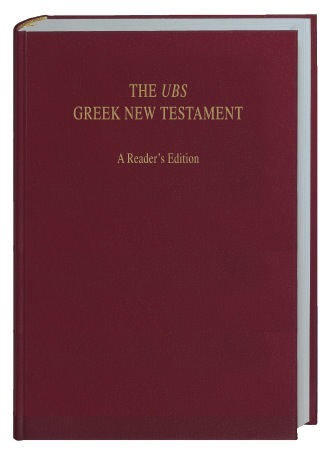
If you haven't read it already, I highly recommend that you see my earlier review of A Reader's Greek New Testament, 2nd Edition from Zondervan for a greater context in understanding this review. If you don't have time to do that, there are four things you should know right up front:
- The UBS Greek New Testament: A Reader's Edition (henceforth UBSRE), is similar in nature to Zondervan's A Reader's Greek New Testament (RGNT from this point forward) which has been published in two separate editions. The first was based upon the Greek text underlying the NIV, and the second is based upon the Greek text underlying the TNIV. All three of these New Testaments include a Greek text with a vocabulary apparatus at the bottom of the page containing definitions for all words that occur less than 30 times in the New Testament. The purpose of such an edition is to allow the reader with at minimum a basic foundation of Greek study to simply read the New Testament in Greek without having to constantly consult a lexicon for words not in one's working knowledge.
- As I explained in the previous review of the RGNT2, although I originally bought the Zondervan RGNT1 for the novelty of having the underlying NIV text, I actually found the volume quite useful, especially as a tool to throw into my book bag that I carry to church on Sundays. I found the idea of a Reader's New Testament in Greek with the vocabulary apparatus is extremely handy when I simply needed to consult the text and wasn't worried about text critical issue or didn't have the time to look up complete definitions in my BDAG lexicon.
- I was never fond of the italic text in the RGNT1, but it was bearable. I was extremely disappointed in the release of the RGNT2 in that although the text was changed to a non-italic font, it used a style with thinner character strokes that actually made the text more difficult to read in my opinion.
- Finally, about a year or so ago, a professor at a seminary extension contacted me wanting to know if I had heard whether the RGNT was being discontinued due to threat of a lawsuit from the United Bible Societies or the German Bible Society. I could not confirm any such lawsuit at the time or that the RGNT was being taken off the market (it was not). However, I did confirm from an off-the-record source recently that there was talk of an actual lawsuit, but it was deemed that since the standard eclectic Greek New Testament is based upon public domain ancient manuscripts, such a suit would not be able to stand up in court.
I'm happy to report that nothing ever came of the lawsuit talk. I would have greatly disappointed (especially in light of 1 Cor 6:1ff) if one Bible publisher had decided to sue another Bible publisher. Rather, the German Bible Society decided to create their own edition of a Greek New Testament similar to Zondervan's RGNT. The UBS version, however, is based upon the UBS Greek New Testament, fourth revised edition. The main features of the UBSRE include the following:
- Translation of all vocabulary items occurring 30 times or less in the New Testament at the bottom of the page
- Translations given according to context
- Definitions of idiomatic word combinations
- Grammatical analysis of all difficult verb forms
- Reader-friendly layout enabling the reader to transfer easily from text to dictionary and vice versa
- An appendix providing translations of all vocabulary items occurring more than 30 times in the New Testament
- The maps from the USB Greek New Testament.
I find it impossible to review the UBSRE without reference to Zondervan's RGNT, so I would prefer to offer a comparative review. From the outset, the immediate difference between these two is size. Although, both have about the same dimensions in height and width (both volumes are around 6" x 9"), the UBSRE is essentially twice as thick as the RGNT. Zondervan's product page for the RGNT states that it contains 576 pages, while the German Bible Society's product pages lists the UBSRE at 712 pages. So why is the UBSRE twice is thick as the competing product, even though it is less than 200 pages longer? Well, it has to do with the very thin paper and space-conserving format used in the RGNT, but I'll write more about that in a moment.

Admittedly, I like the soft, leather-like Italian DuoTone cover on the RGNT better than the hardcover binding of the UBSRE. The Zondervan product feels like a Bible, while the UBS edition feels like a book. The UBSRE is bound in what has become the signature burgundy cover with gold lettering that is used with most editions of the UBS Greek New Testament. However, I know that they also produce flexible covers, and I believe one would be appropriate for this edition.
Nevertheless, it's what's inside that counts, and this is where the UBS shines. I'll get to the layout issues in a moment, but first a few comments on the vocabulary apparatus. The apparatus itself is referred to in the introduction and on promotional materials as a "Running Greek-English Dictionary." The RGNT has this, too, of course, but the UBS edition may just be better. The definitions have been adapted from Barclay Newman's Concise Greek-English Dictionary of the New Testament contained in many UBS editions of the Greek New Testament. Of course, because of space, the definitions have been shortened based upon the context. Therefore, the the contextual decision may theoretically imply some amount of interpretation upon the editor's part, but this would not be any different from using Trenchard's glosses in the RGNT. Further, the running dictionary is not meant to replace use of a lexicon, but merely to allow quick access to the meaning of the text in certain contexts.
The UBSRE also breaks with the Zondervan editions in that it offers grammatical help on what the editors consider more difficult forms. So for instance, in John 1:42, both the UBSRE and the RGNT offer a definition for ἐμβλέψας. The RGNT: "ἐμβλέπω, I look at, consider." The UBSRE: "ἐμβλέπω aor act ptc m.s.nom, look straight at." For many readers, this extra grammatical information is going to be very helpful.
Like the RGNT2, the UBSRE also offers a mini glossary of Greek vocabulary words occuring more than 30 times (the ones that don't get listed with the text) in case the reader simply forgets what shoudl be a memorized word. But this is also a place where the two editions differ greatly. The word list in the RGNT2 is based on Warren C. Trenchard's Complete Vocabulary Guide to the Greek New Testament, so it's definitions are fairly short as one would expect. So, for instance, if one were to look up ἀγαθός in the RGNT2 appendix, would would find this entry: "ἀγαθός, ή, όν (102) good" (the numeral indicates how many times the word occurs in the Greek NT). However, because the definition appendix in the UBSRE bases its entries on Barclay Newman's dictionary, one will find a much more detailed entry: "ἀγαθός, ή, όν good; useful, satisfactory for one’s (its) purpose, fitting, beneficial; sound (of trees), fertile (of soil), happy (of days); in a moral sense upright, just; kind, generous; clear (of conscience); perfect, inherently good (of God); τὸ ἀγαθόν the good, what is good; what is right or upright; what is beneficial or advantageous; τὰ ἀγαθά goods, possessions; good things (Lk 16:25); good deeds (Jn 5:29)." That's quite a difference, but to be fair, one could argue that the RGNT2 offers the most essential information with the understanding that more detail can be derived from other resources. But again, for some readers, this extra information will be seen as quite helpful. I should also point out that the glossary in the RGNT only fills a little less than six pages, while the corresponding feature in the UBSRE fills 22 pages.
This leads me to what I believe is the most significant difference between the UBSRE and the RGNT2: layout and readability. The UBSRE is simply easier to read than the RGNT2. It's font is larger and the text is laid out leaving more white space on the page. Further, the running vocabulary list in the UBSRE runs in a two-column list which allows one to easily find the word he or she is looking for.
I took my own scans of each edition for this review rather than relying on the PDFs made available from each publisher. I thought this might give a fairer comparison between each edition. If the lines don't seem quite straight, it's from a less than perfect attempt on my part to hold the volume flat on my scanner.
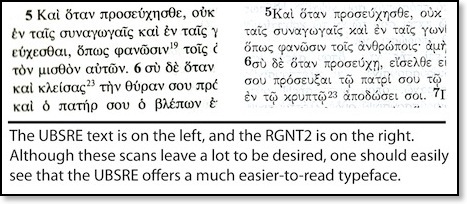
As I stated in the review of the RGNT2, part of the problem comes from my perception that Zondervan, normally a maker of quite excellent reference works, has an unhealthy preoccupation with thinline Bibles. Since the RGNT is a New Testament, someone in marketing or layout and design must have suggested than a thinline form factor be adopted. I'll be the first to admit, that the RGNT fits much more nicely in the hand than the UBSRE. However, this is strictly form over function. The UBSRE doesn't suffer from small print, cramped text, or near as much bleed through (which is even evident in the above samples) as the RGNT2. This issue is also apparent when you look at a full page spread of each edition.
[Note that neither of the scans below captured the full margins of either edition since my scanner space was smaller than a full page spread of either edition.]
First, the RGNT2 (click on the image to get a larger, more detailed view).
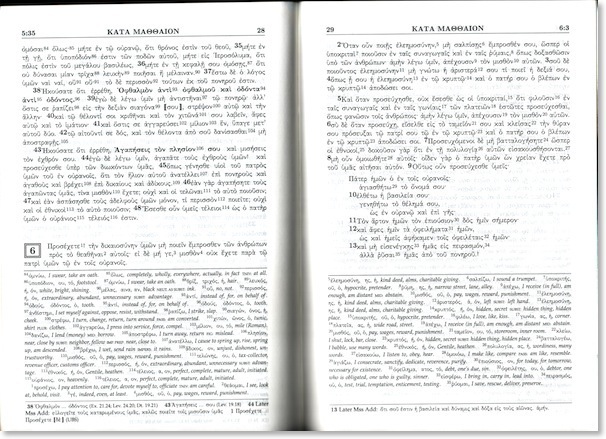
And now, the UBSRE (again, click on the image to see a larger, more detailed view):
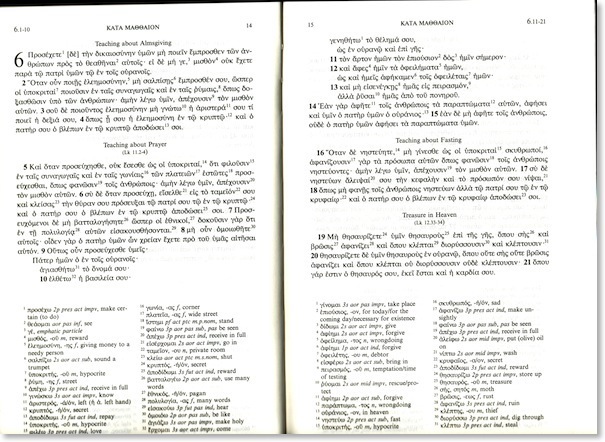
In my opinion, the UBSRE is much more inviting. Section headings separate pericopes, and parallel passages in other gospels are also noted. Of course some people prefer a straight text without section headings. If this is the case, the RGNT may be preferred to those readers. Finally, finding the definition of a word in the UBSRE is made much simpler and quicker with the two columns, rather than hunting through the paragraphed text of the RGNT's apparatus.
WHAT'S MISSING?
Not much. There's very little in the RGNT2 that's missing in the UBSRE. However, I felt the Scripture references for OT quotations in the RGNT2 were a very welcome addition, and one that the reader will not find in the UBSRE. The maps are a bit nicer in the RGNT2 than the standard UBS maps. The RGNT2 also added a few, sparse textual notes in addition those that referenced divergences from the UBS text. The reader of the UBSRE will still need to consult a more traditional edition to see textual issues.
Something should also be said about price. The UBSRE is significantly more expensive than the RGNT. I've stated for a long time that UBS prices were out of control, and this edition is no different. Even with discounts at places like Amazon or CBD, one can expect to pay about $20 more for the UBSRE over the price of the RGNT.
FINAL EVALUATION
Although initially, I was very excited about the release of the RGNT2 and its promised improvements over the first edition, I was quite disappointed in the final product. Yes, the thinline aspect of the RGNT2 might initially seem like a bonus over the twice-as-thick UBSRE, but in actual use, function simply wins out over form for me. The UBSRE is a better product because the designers of it did not choose to take shortcuts necessary to create a thinner form factor. From what I've heard, the RGNT had been greatly cutting into the sales of UBS/NA Greek New Testaments over the past few years, and the UBSRE is nothing less than a counter strike, and a significant one at that.
One last thing. If you read my review of the RGNT2, you'll remember I lamented that a ribbon marker was missing, in spite of the fact that one had been promised in early promotions, and even listed as a new feature on early shots of the box cover. Well, potential purchasers of the UBSRE will be glad to know that it does, in fact, come with a ribbon marker. Admittedly a minor detail, but handy for any reader, nonetheless.
A Reader's Greek New Testament, 2nd Edition: Hands On Review
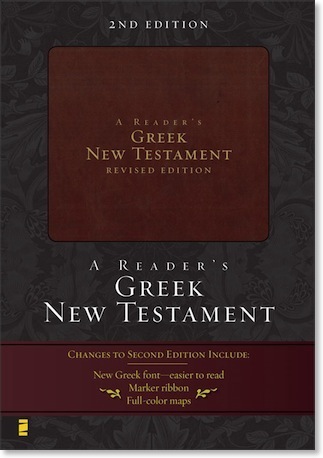
What No One Wants to Talk About
There's a dirty little secret among ministers throughout Christendom: most of them have let their biblical languages slide after graduating seminary. It's sadly understandable, I suppose. Learning a language is hard enough, but maintaining that language takes time and discipline. It's not that ministers are undisciplined (well, maybe some are), but when they get out of school and into the "real world" of ministry, they find new obligations and demands upon their time. Reading the Bible in Greek or Hebrew is replaced with an occasional word study to get at the "meaning" behind key biblical words.
That's where a book like A Reader's Greek New Testament (from this point forward, simply RGNT for the general work and RGNT1 and RGNT2 for the respective editions) can help fill the gap. I'm told there are 5,347 distinct words in the Greek New Testament. The average student taking elementary Greek will only learn a little over 300 vocabulary words in that first course. This accounts for roughly all words that occur in the Greek NT 50 times or more, or approximately 80% or so of words occurring in the NT. A second course related to syntax and exegesis will increase the number of learned vocabulary falling somewhere between 30 and 10 occurrences. The key feature of A Reader's Greek New Testament is the vocabulary apparatus at the bottom of the biblical text which gives definitions for all Greek words occurring 30 times or fewer.
This is a handier tool than one might at first realize. You see, there's another dirty little secret, and this one is among even the most trained academics and theologians: very few scholars ever memorize all 5,347 words. I've sat under quite a few professors in my time, some of whom are quite well known in the world of biblical studies. However, I could probably count on one hand the number of individuals I've known who could "cold read" any passage in the NT and do so well. I admit that years ago I tested this out on more than one occasion on more than one professor. I began to pick up on the fact that when we had a focal passage for study for a day, a professor could read from the Greek quite smoothly. But as soon as a question was asked about another passage, stumbling and stuttering began as an attempt was made to read the unplanned text. Again, I can count on one hand the individuals I've known who seemed to be able to smoothly read aloud any passage from the NT without advanced preparation.
I won't be a hypocrite. I admit up front that I don't have all 5,347 words memorized either. It's a worthy goal, but I haven't reached it, and frankly at the moment I'm not even attempting to. At some point way back, I worked my way through one of those boxes of 1,000 Greek vocabulary cards. Those boxes will get the Greek student down to about all words that occur 10 times or more. I use my Greek almost daily, but I haven't reviewed all 1,000 vocabulary cards in a long time. If I had to guess, I would assume that as of this moment, my current mastery of Greek words falls somewhere below that 30x mark and above that 10x mark.
The Value of the RGNT
I picked up the first edition of the RGNT based mostly on the sheer novelty of the fact that it represented a different Greek text than the "Standard Edition"; that is, the Greek text underlying the NIV Bible (more about that in a moment). But the more I used it, the more I saw the value of what it was designed for: the RGNT allowed me to read the NT in Greek without having to constantly look up words that I didn't know the definition of off the top of my head. They were simply defined at the bottom of the page. Of course, there's value in consulting the lexicons for more in-depth treatment, but I would suggest that very few non-specialists who learn Greek (or at least take Greek classes) ever really read Greek. Instead, they simply muddle their way through. I've been there myself, and it's taken quite a bit of study to proceed further. But the RGNT will help anyone with a basic foundation in Greek studies actually read the NT in its original language.
Although for years I'd carried with me one of those "standard" Greek texts (first the UBS 3rd edition, and later the 27th edition of the Nestle-Aland text), I found myself picking up the RGNT more and more after I bought it. I especially grabbed it for non-academic purposes such as church use. I found that when teaching a Bible study, if I was asked a question that required consulting the Greek text (which happens now and then), I was able to stumble around less on those cold readings if I had the RGNT. So I would imagine that over the last couple of years, when carrying a Greek NT with me, the RGNT has been my choice at least 50% of the time.
The value of the RGNT is fairly universal. Certainly, it's a great tool for the person in ministry, who's out of school, but wants to continue using his or her Greek skills. It allows a pastor to realistically work in actual Greek for exegesis when preparing a sermon because less time is involved. For the student who has recently begun studying Greek, it's a great way to stay in the Greek text and rely less on outside aids. Of course, I've warned folks that the average professor is probably not going to allow it for an exam. But even beyond new students and graduated students, the RGNT is an immensely practical resource for looking to the original languages first as opposed to a translation. Some might be tempted to call it a crutch, but I would contend that the more a person used the vocabulary apparatus at the bottom of the page, the less it would be used over time as new vocabulary was mastered.
The Underlying Text
It's very important that anyone considering the use or purchase of the RGNT know that text itself varies slightly from the accepted, so-called "Standard" eclectic Greek text. For those unfamiliar with this, the average Greek NT bought off the shelf today, whether a UBS 4th edition or a Nestle-Aland 27th edition, does not represent a single Greek manuscript, but is rather an amalgam of what is considered the best and most reliable readings from the manuscript evidence. But sometimes opposing variant readings have such strong evidence that scholars disagree over which variant represents the original. There are formal, but not always rigid rules for making such decisions and this process is known as textual criticism. Bible translators use these standard texts when creating or revising a translation of the Bible, but I suppose the third dirty little secret today is that every translation on the shelf contains some renderings in which the translation committee disagreed with the decision of those who put together the standard text. But until the first edition of the RGNT, it was difficult determining with any translation how many times a committee went rogue against the decisions in the standard text.
The first edition of the RGNT was released in 2003 containing a reverse-engineered Greek text reflecting the translation decisions found in the NIV Bible. So how many times did the NIV translators opt to go with variant readings? Evidently, the magic number is 231. Is that good, bad, on par with other translations? Who knows? This had never been done before (to my knowledge). The newly released second edition also features an underlying Greek text, but not for the NIV. Rather, the underlying Greek text of the RGNT2 is based upon its successor, the TNIV. Regular readers of This Lamp will correctly assume that I'm very pleased with this decision. I've been concerned in the past that Zondervan was still holding on too tightly to the NIV rather than giving deference to the newer and more accurate TNIV. Not only is this change of translations between editions forward-thinking, the RGNT2 represents one of the first reference work related to the original Greek associated with the TNIV, further legitimizing academic use of this translation.
But wait--there's more. One might expect the number of deviations in the Greek text underlying the TNIV to remain close in number to those in the NIV. Not so. Would you believe that the number of deviations from the standard text in the TNIV is 285? That means there is well over 50 separate instances in which the TNIV Committee on Bible Translation made decisions for readings that differed from their predecessors who worked on the NIV. Are these decisions good ones? Well, that will have to be examined, but at least now with RGNT2, we know where they are.
Further, this will settle some questions about the differences between the TNIV and NIV once and for all. For instance, a while back I wrote about the difference between the two translations in their rendering of Mark 1:41 (see here and here).
|
Mark 1:41
|
|
|
NIV
|
TNIV
|
| Filled with compassion, Jesus reached out his hand and touched the man. “I am willing,” he said. “Be clean!” | Jesus was indignant. He reached out his hand and touched the man. “I am willing,” he said. “Be clean!” |
At the time, I wrote to the International Bible Society hoping that my question about the extremely different rendering would be passed on to the TNIV CBT. However, and IBS intermediary answered the email himself and went to great length to defend a decision to translate σπλαγχνίζομαι/splagchnizomai (the underlying Greek word translated in the NIV as "filled with compassion") as indignant in the TNIV. It didn't make much sense to me then, and as I looked at the issue a bit more, I discovered that there was another variant to Mark 1:41 that included the word ὀργίζω/orgizō (be angry, be furious) instead of σπλαγχνίζομαι/splagchnizomai. Upon receiving the RGNT2 in the mail this week, one of the first things I looked up was Mark 1:41 and I was not all too surprised to see that the TNIV does in fact use the variant that contains ὀργίζω/orgizō. Originally, upon receiving the RGNT2, my plan was to sell the first edition. However, I now believe it would be valuable to hold on to both for just these kinds of comparisons.
Improvements in the 2nd Edition
In addition to updating the textual basis, a number of other improvements have been made in the RGNT2. I've complained before that I didn't care for the italic Greek font in the RGNT1. Most will be pleased to know that the text has been completely reset in a non-italic font. Unfortunately, I'm still not satisfied with the new font, but I'll speak more to that below.
The RGNT is known for including vocabulary words at that bottom of the page for all words that occur 30 times or fewer. But what if the reader forgets the definition of one of those words that occur more than 30 times? I'll never forget the time I was in a class about a decade ago and it was my turn to recite a text and I completely blanked on a very basic, frequently occurring word (ποιέω/poieo). Well the new RGNT2 includes a "mini-Lexicon" (it's actually called that) in the back that includes all those words occurring 30 times or more. It's a good way to review vocabulary as well. All definitions, like those in the apparatus with the text are taken from Warren Trenchard's Complete Vocabulary Guide to the New Testament. The mini-lexicon takes up only 6 pages, much fewer than I would have imagined.
Four color maps relating to the New Testament have been added. These maps will be recognizable to anyone who's bought a Zondervan Bible in recent years, but they are certainly a welcome addition. Old Testament quotations within the NT text are now referenced in a separate apparatus at the bottom of the page. This second apparatus also includes notations to differences in the standard NA/UBS Greek text as well as a few minimal textual notes such as "Later MSS Add... ." Again, no one is going to be able to do hardcore textual criticism with this New Testament, but the improvements in the RGNT2 help to make it a more complete package for most situations.
Like the previous edition, the new RGNT2 comes in an "Italian Duo-Tone" cover, which is a very leather-like imitation leather. Personally, I like the cover just like I did in the first edition. It feels immediately soft like a leather that has experienced a good amount of use already. I'm not sure any of us know what these new kinds of imitation leathers will look like in 20 years, but I'm not concerned. And I especially appreciate the lower cost (about $23 on Amazon.com).
What I found very interesting, though, is that contrary to early advertisements promoting a marker ribbon, no such item is included. In fact, as of this writing. the box cover image on both Amazon.com AND the Zondervan website (reflected at the top of this post) promises a marker ribbon. Evidently, the ribbon was cut at the last minute, but still done in time to update the box cover which now sports only two "Changes to Second Edition" in the copy on the front of the box (the new supposedly easier to read Greek font and the full-color maps).
I might also point out, too, that when I did my earlier "first look" (i.e not hands on) review of the RGNT2, I speculated based on released PDF files that this new edition might have wide margins. Sadly, it does not.
A Reader's Edition That's Difficult to Read
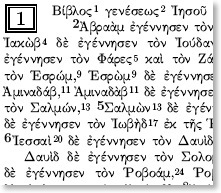
One of the supposed improvements in the second edition over the first edition of the RGNT is the new non-italic typeface (seen in actual size to the right). It's true, I've never liked italic Greek typefaces or saw the need for them. My first Greek New Testament years ago was a USB 3rd edition that had an italic, but readable typeface. However, I thought the 4th edition italic font was horrible and I've never used it. I have generally preferred instead to use a Nestle-Aland 27th edition Greek New Testament with non-italic type. I was never fond of the italic type in the RGNT1, but the work itself was so very practical that as described above, I've used it regularly over the last two or three years.
I was excited about the prospect of non-italic type in the RGNT2. Yet, when I saw the type of the main body text, I was astounded. I believe I said aloud, "My goodness, it's actually worse." The strokes that form the characters in this Greek font are so very thin that in my opinion, the second edition is even more difficult to read than the first. If you think about it, this completely contradicts the concept of a supposed "Reader's Edition" because what Zondervan has produced is a work that is difficult to read! I can only imagine that extended time spent with the RGNT2 would seriously make one's eyes ache.
And to illustrate the oddity of this thin Greek font, all I have to do is point to the English font in the introduction of the work. It looks like it is probably about a 10 point Times-based font. It's easy to read. But it's in stark contrast to the thin letters in the Greek text. And to add even further evidence to the impracticality of this font, I should point out that the compilers of the RGNT2 chose an entirely different and thicker (i.e. normal) font for the Greek in the mini-lexicon. If they had used the same Greek typeface in the main text that they had used in the lexicon, I would have no complaint.
I showed the new edition to one of my Greek students with the original edition for comparison. I waited for a reaction. He looked back and forth at the two editions and then he asked, "Wait a minute...is the new typeface smaller?" I'm not so sure it's smaller, but it's definitely thinner. In fact because of the new typeface that takes up less space, the second edition comes in at 11 pages shorter than the first edition--and that's including the mini-lexicon in the second edition!
I can only speculate that the desire to have so few pages comes from what I see as a preoccupation that Zondervan has with thinline Bibles. Personally I can't stand thinline Bibles because compromises have to be made to reach a smaller size and that usually means small, cramped type and pages that are way too thin. And, of course, think paper leads to text bleed-through from underlying pages. All three are true for the RGNT2, and all three make this edition even more difficult to use than the first.
I complained to Zondervan about the thinline format because of the sacrifices in the type and paper, but Zondervan's marketing shows that people really seem to prefer thinline Bibles. I'm sure they do. They are compact and easy to carry, but personally, I don't find them practical for regular/heavy use. If I were to make a publishing rule regarding such things, I'd say never produce thinline reference works.
Further, in regard to my complains about the type, I was told that at the recent SBL & ETS conferences, attendees were given the chance to compare the two editions:
"I can say this that the vast majority of those at the convention who looked at the two editions preferred the second edition's font over the first as being much easier to read. Even though the first edition was $5.00 cheaper than the second edition and we had lots of both editions at the conventions, we sold out of the second edition first at both conventions, and 'from my perch' I made sure that people looked at both fonts if they were unaware of the first edition."
My hunch is that people looking at the two simply prefer the non-italic type in the second edition over the italic type in the first, but time will tell. It's a different issue altogether when one is actually trying to use a work like this as opposed to simply looking at it in a conference booth.
I'm going to really attempt to use the second edition despite my initial misgivings. I didn't like the italic type of the original edition at first, but it grew on me. However, I don't know if that will be possible with a font that's simply difficult to read.
No Longer the Only Game in Town
About a year or so ago, I had a professor from a seminary extension contact me about the original RGNT. He was using it in his Greek classes, but he had heard that the United Bible Societies were going to sue Zondervan over their Reader's Edition in spite of the 231 places where it diverged from their text. He was so concerned about this, he had been buying up extra copies of the RGNT for his future students to buy from him. He wanted to know if I had heard about any of this. I had not heard about it, but I didn't believe at the time that any such lawsuit was be tenable in a court of law because the UBS text is made up of an arrangement of public domain ancient manuscripts. Later on I would find out that such an idea for a lawsuit had indeed been considered, but eventually abandoned because of the exact reason I suspected.
Nevertheless, there is a new UBS Greek New Testament: A Reader's Edition to compete with Zondervan's. Granted, it's $20 more expensive than Zondervan's (UBS prices are out of control in my opinion) even at discounters, but it may end up giving Zondervan's RGNT2 a run for it's money. I have not held one in my hand yet (when I do, I'll offer yet another review), but based on PDF's, I wonder if they haven't built a better mousetrap. My concerns about the typeface in Zondervan's RGNT don't look like they will be an issue in the UBS edition based on what I've seen. I would invite you to compare the PDF sample for the UBS Reader's Edition to the PDF sample for the Zondervan RGNT2 and let me know your thoughts. I should also point out that the UBS text is about 200 pages longer than the Zondervan version and it is definitely not a thinline.
Concluding Thoughts
Zondervan has developed a wonderful concept with its Reader's Greek New Testament which is aimed at allowing a person with at minimum basic Greek skills to simply read the New Testament in its original language without having to consult a full lexicon every few words. Most of the additions to the second edition are welcome and for the most part improves upon its predecessor. I especially like having the text that underlies the TNIV. Since I teach out of the TNIV at church, the RGNT2 would seemingly make for an excellent complementary resource. Unfortunately, the ghastly thin typeface in the second edition threatens to defeat the purpose of this being a reader's edition because it's simply difficult to read. If the new UBS Reader's Edition begins to cut into Zondervan's sales, I hope they will consider resetting the type as quickly as possible. Unfortunately such projects never take place quickly, and I wouldn't expect anything different from the current RGNT2 for at least three years or more.
TNIV Truth: Dig Deeper
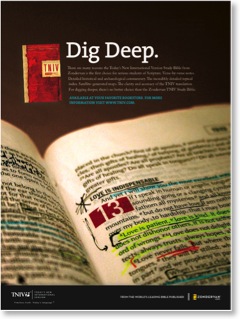
To read why I like this ad for the TNIV Study Bible, as well as my thoughts on work still to be done, read my latest post at TNIV Truth.
First Look: A Reader's Greek New Testament, Second/Revised Edition
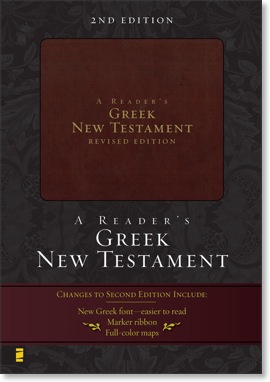
SOME BACKGROUND: THE FIRST EDITION
I've always found A Reader's Greek New Testament (RGNT from this point forward) to be an extremely practical resource. The RGNT addresses the issue that while there are over 5,000 distinct words in the Greek NT, the reality is that many of this words only occur a few times or even in single occurances. While it's an admirable goal for a student of Greek to memorize every word, it's not a reality for most. Most introductory grammars, in fact, only cover a little over 300 words, but these words occur so frequently that they account for roughly 80 of the entire New Testament. But that remaining 20% is still enough from keeping the average person who has a familiarity with Greek from sitting down and reading the New Testament in its original language as easily as one might read an English translation. In fact, in my experience and observation, I've known personally of only about two or three people who can really read the Greek NT without stumbling. Oh, sure, the dirty little secret is that any of us can read a passage just fine when we've taken the time to work through it ahead of time. But as soon as someone asks us a question about a different passage--one that we haven't prepared beforehand, we stumble and stammer as we try to read it in a quick and efficient manner.
The RGNT is noted for including lexical forms for all words of the Greek New Testament that occur 30 times or less. If this sounds like a crutch, think again. The reader still has to know his or her Greek grammar fairly well to use this resource. In fact, I tend to carry the first edition of the RGNT with me to church on Sundays. If I need to look up something quickly, and come across a word that's not part of my working vocabulary, I can look at the footnote at the bottom of the page. It's not realistic for me to carry a lexicon with me to church, and I usually don't have my MacBook so that I can access such tools in Accordance. Perhaps one day, I'll make time to memorize all 5000+ words in the Greek NT, but for right now it's not a practical goal and the RGNT is an ideal solution.
The other distinct feature of the RGNT first edition has to do with its textual basis. Most might assume that this is simply an edition of the current UBS/NA eclectic Greek text with a special apparatus. Not so. The Greek text in this edition is actually one that has been retrofitted, so to speak, to match the text that underpins the New International Version. The reality is that every translation committee makes decisions that sometimes causes them to choose a different textual route than the majority opinion of the UBS/NA committees. The RGNT first edition has about 200 instances, all noted in the footnotes, where its text differs from the standard text.
IMPROVEMENTS/CHANGES IN THE SECOND EDITION
New Greek font. I don't know if the font itself is actually a different font, but the main difference from the first edition is that the text in the second edition is not in italics. And I say, "Thank goodness!" My major complaint about the first edition of the RGNT is the italicized text that is extremely difficult to read. I have no idea why some publishers of Greek texts like to do this. The UBS 4th edition Greek NT uses a horribly thin italicized text also making it difficult to read. Thankfully, Zondervan changed this policy in the RGNT 2nd edition.
However, the font itself does look slightly smaller than the original edition. I've made a comparison in the graphic below that displays the first page of Matthew's Gospel on the left in the first edition and with the second edition on the right (note that the image below is not actual size).
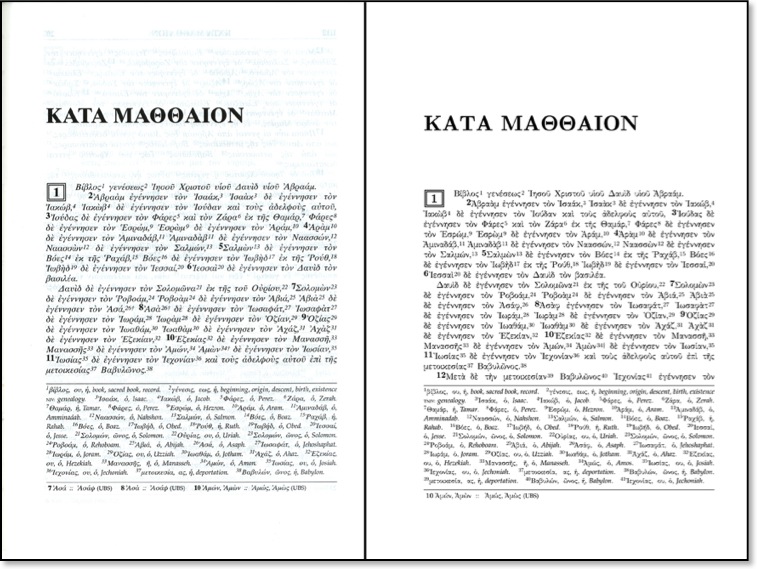
The observant reader may notice that there's slightly more text (most of Matt 1:12) on the second edition page. Therefore, the font is either tighter or smaller. Zondervan offers a PDF sample of the RGNT2 featuring the first five pages of Matthew. The second edition ends with Matt 3:17 while the equivalent page in the fist edition ends with 3:15. Two verses--is that a big deal? Probably not, but there is definitely an attempt to use fewer pages. Why? Because while there are more features in the RGNT2, but there are actually fewer pages than the first edition. Therefore, an attempt was made to conserve space. And while I wish Zondervan had not chosen to use a tighter/smaller font, I will say that regardless, the new text is much easier to read than the italicized text of the first edition.
But that brings us to another issue, and frequent readers of This Lamp will have to pardon a familiar complaint that I've discussed many times before. This New Testament, (presumably) like its predecessor is a thinline. How do I know this? Well, in spite of the fact that complete measurements have not been released, we do know a few things. I'm guessing the dimensions are a bit wider because the outer margin on each page is wider (see more below). We also know that although there is about a twenty page difference in the two editions, the weight is comparable (1.065 lbs. for the first edition vs. 1 lb. for the second edition). Thickness measurements for the second edition have not been released, but the first edition is 7/10 of an inch thick. Since the two editions weigh virtually the same, I can only assume that the second edition will be just as thin.
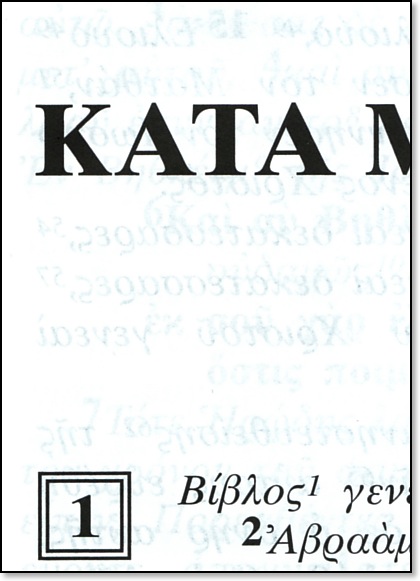
Personally, I hope that one day, publishers will get over their infatuation with thin Bibles and realize that the target market for a resource like this does not mind having a book that is somewhere between one inch and one and a half inches in thickness. I'm sorry, but cramming 576 pages into 7/10 of an inch is ridiculous.
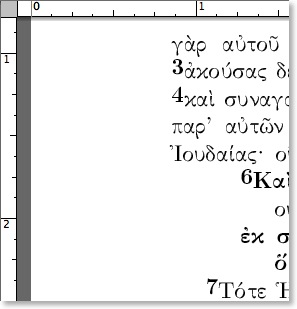
Again, this is an area where I with publishers would realize that those who buy products such as the RGNT appreciate not just thicker paper, but also wide margins for making notes, Regardless, whereas, the first edition's anemic margins were useless for any annotations, the new wider margins begin to approach a minimum width for note-taking,
Mlnl-Lexlcon. For those occasions when the reader forgels one of those words that occur more than 30 times, a new mini-lexicon has been added, presumably in the back of the RGNT.
Maps. Four new color maps have been added to the second edition of the RGNT. Already UBS/NA Greek New Testaments tend to have basic contextual maps inside the front and back covers. With the addition of these maps to the RGNT, this resource begins to take the feel of a standard reference tool and even a one-stop instrument for public use.
And the rest. Like the first edition, the new RGNT comes in an Italian Duo-Tone binding, I've stated before that I like this material just as much as actual leather. Assuming that these covers are going to hold up over decades-long use, I find them to be a very adequate substitute for real leather, especially if this keeps the price down. Perhaps Zondervan could put a disclaimer on the copyright page: "No cows were harmed in the publishing of this New Testament."
And of of course, the RGNT second edition will continue to offer lexical forms of words that occur less than 30 times in the Greek NT as well as noting where the text diverges from the UBS/NA texts. I'm pleased that they continue to keep these notes on the same page as the NT text, in footnote fashion, rather than by some other means.
I'll have more to say about the RGNT2 after I get my hands on one in November, Butfrom what l can already determine, it is already looking to be a great improvement over what was already a very practical and useful resource.
Inspired By...The Bible Experience Wins Audiobook of the Year
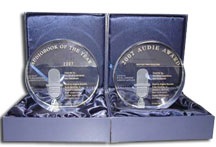
GRAND RAPIDS, Mich., June 4, 2007 – The most ambitious and bestselling audio presentation of the Bible ever produced, Inspired By… The Bible Experience (New Testament), has been named Audiobook of the Year, the most prestigious award for excellence in audiobooks, by the Audio Publishers Association (APA).
The award recognizes the audiobook that made the greatest impact on the audio publishing industry. To date, the New Testament edition of Inspired By… The Bible Experience has sold more than 300,000 units in eight months to become Zondervan’s fastest-selling new Bible, outselling perennial bestsellers. The combination of the product’s original score, theatrical production, world-class talent and use of the most accessible Bible translation, the TNIV (Today’s New International Version), also earned Inspired By… The Bible Experience a second Audie in the Inspirational/Spiritual category. The winners were announced during the Audies ceremony on Friday, June 1, in New York City.
Making the Case (Yet Again) for Wide Margin Bibles
Although I've provided the link above, it won’t remain active after a few weeks, so I’ll include a screenshot below:
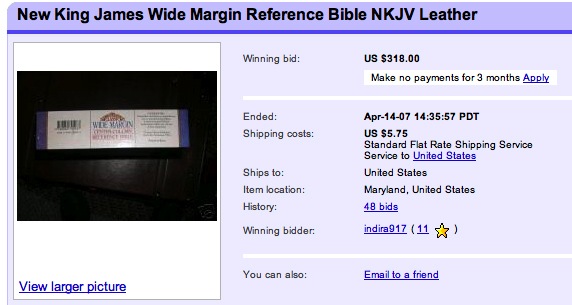
It boggles my mind really to think that someone would pay $318 for a wide margin NKJV--and a bonded leather one at that! But Larry summed it up quite well in his comments when he said this:
This must be proof positive that people are passionate about wide margin Bibles. More than $300 for a bonded leather cheapo Bible from Nelson? A NKJV?
And the fact that Nelson allowed this to go out of print while Crossway is publishing multiple note-taking Bibles may perhaps play some role in the NKJV's fall and the ESV's rise. (Certainly, there are other factors, but given the investment that publishers claim to make in new Bibles, why wouldn't they want to make their franchises available in every format that there is demand for?)
I think you put your finger on it a few months ago when you pointed out that while sales of wide margins may appear weak, they are sold to opinion makers -- and thus influence many more sales.
I've had representatives from three different Bible publishers tell me that wide margin Bibles just don't sell well. But it's that last statement made by Larry that I believe most Bible publishers just don't get. But Crossway gets it. They know that the teachers, preachers, and other serious Bible students want wide margin Bibles. And even if these particular buyers don't represent a large market, the fact is that this is the group that influences the purchases made by those sitting under their instruction. The fact that Crossway gets this is evidenced by the fact that they offer four different ESV Bibles with wide margins: The Deluxe Reference Bible, The Journaling Bible, The Single Column Reference Bible, and the Wide Margin Reference Bible.
But where are the decent wide-margin Bibles from the other 21st century translations (NLTse [2004], HCSB [2004], NET [2005], TNIV [2005])? Let's run through that list real quick.
New Living Translation
The original NLT1 (1996) had one of the best wide margin Bibles I've ever seen in terms of the Notemakers Bible. It had a healthy one and a half inches of space in the margins of a single-column text and two inches of lined space at the bottom for journaling. But since sells weren't that great, Tyndale has decided not to release an edition in the NLT second edition.
But why didn't the Notemakers Bible sell? The Living Bible and its inheritor, the New Living Translation have always been a bit of a populist Bible. While scholars put down the original Living Bible, Christians bought them in droves, and many testified that this was the first Bible they ever really understood. But these were probably not the kind of folks--for the most part--who would have been interested in a wide margin edition for their own notes.
The 1996 NLT wasn't that far removed from it's predecessor--especially in the public's eye--in spite now being called a translation rather than a paraphrase. Regardless, the top notch team of Evangelical scholars who produced the 1996 first edition reconvened to tighten up the translation, bringing it closer to the autographs and hopefully bring about the respect the NLT deserved. That resulted in the 2004 NLT second edition, which although quietly introduced was radically different than the first edition.
To gain even greater credibility, Tyndale has begun the Cornerstone Biblical Commentary Series, based solely on the NLTse. From the two volumes I have so far in the series, I can say that it's an excellent evangelical commentary series on the Bible. And I'm not sure it could have been based on the earlier NLT1 (let alone the Living Bible) without a great amount of work. But the NLTse is a different creature! And now that a commentary series is based on it, what would be a better match than an NLTse Bible with wide margins to study along with it and make notes? It seems to only make sense to me.
Holman Christian Standard Bible
There is only one wide margin HCSB Bible available: The HCSB Minister's Bible. So far it has received mixed reviews (see my review here). The main complaints stem from paper that is too thin and wide margins that really aren't that wide. Plus I've had more than one person email me who was not a minister saying they would like to use it simply to have a wide margin HCSB, but have been reluctant to do so because they feel funny carrying around something with that title on the spine. I'm really surprised there aren't more offerings here from Holman considering the HCSB is now the default translation in all of Lifeway's Sunday School curriculum. It would seem to me that a decent wide margin HCSB would be a perfect match.
NET Bible
I'm not totally surprised that the NET Bible has not seen a wide margin edition yet. Certainly with 60,000+ notes, one would wonder what could be added. Plus, the NET is still trying to gain the attention of the larger Evangelical world. Selling through more than merely mail order might help them out some. To me of all these Bible translations listed here that don't have wide-margin editions, the NET is the only one that gets a pass.
Today's New International Version
I would guess that the possibility of a TNIV Wide Margin Bible primarily suffers from the mixed track record of Zondervan's wide margin NIV and NASB Bibles. But if these editions have not sold quite as well as Zondervan would have liked there might be a reason why. Last year when I posted a Survey of Wide Margin Bibles by Version, I counted two other publishers of wide margins NIV's besides Zondervan and and three other NASB offerings. Could it be that the market for NIV and NASB wide margin Bibles is simply flooded? Consider also that most NASB aficionados have been using the classic single-column reference edition since the 1971 NASB. Foundation Press now offers a variety of high quality leather bindings in the classic reference edition, while Zondervan only offers hardback and bonded leather. There is a similar weakness for Zondervan's wide margin NIV: Cambridge offers a variety much higher quality bindings (scroll down to the bottom of the page for the previous link).
I'll come back to this, but one thing I believe that publishers like Cambridge and Crossway might get and Zondervan might not, is that people who buy a Bible for taking notes in want to use this Bible long term. Generally, there's going to be a preference for higher quality bindings. And if there's a choice, quality will trump cost--at least for these buyers.
The TNIV does have a wide margin represented in the "Squared" Bible. However, the TNIV Squared Bible breaks two cardinal rules of wide margin Bibles: (1) It is a thinline Bible, so the paper is not suitable for heavy annotations, and (2), as a two-column text, it does not allow any margin for the inner column. Ultimately, this Bible misses its intended market.
There is a TNIV Reference Bible coming out later this year, and many of the "gatekeepers" will use it as the best option of what's available, but I get emails and comments on this blog every week bemoaning the fact that it's not a wide-margin TNIV Bible. I would hope that eventually Zondervan will offer the TNIV Reference in a wide-margin offering.
Here's what most publishers are missing...
Most publishers don't get two things about wide margin Bibles:
- Despite lower sales, wide margin Bibles are for gatekeepers, and gatekeepers influence the translation choice of others who will buy the more popular editions.
- People who are in the market for a wide margin Bible want a quality Bible: genuine leather or better and a solid stitched binding. A wide-margin Bible is going to be considered by most to be a long term investment.
Finally, there's another little secret that Bible publishers don't realize, and I almost even hate to bring it up. But as evidenced by the sale of a $318 wide margin NKJV on eBay, people who want wide margin Bibles are willing to pay extra for them. It is well known that publishers make limited printings of some Bible editions. Why can't this be done for wide-margin Bibles, too? Heck, I imagine most of us would even be willing to order them straight from the publisher if there's some fear they wouldn't sell in stores. But most of us who would like to use a wide margin Bible would be willing to pay upwards of $100 knowing that it would be a long term investment, knowing that it should be a publication made with the utmost standards in binding and materials.
The wide margin survey that I posted last year remains one of the most popular pages on this blog. It gets hits everyday. There's a market out there. The products just need to match the demand.
TNIV.com Completely Revamped
Take some time to explore it. I know that the folks at Zondervan were working on the site well after business hours last night trying to work out the kinks. If you find an error or have a suggestion for improvement or simply want to offer your thoughts on the redesign, please use the feedback form on their site. Or you can email me and I'll pass it on.
TNIV Truth: New TNIV.com Preview
Zondervan Releases Free Easter Story from the Bible Experience
 |
|










